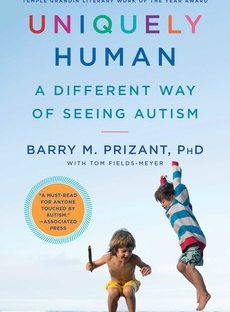I recently finished reading the book Uniquely Human: A Different Way of Seeing Autism, written by Dr. Barry M. Prizant. It took me only a few days to “read” (I listened to the audiobook version) the whole thing, because I was enjoying it so much.

My motivation for searching out this book arose from a desire to better understand my current piano students who have autism. This was the book I settled on after searching on Amazon.com for a book on the topic that had excellent reviews.
This book did not disappoint.
The author, Dr. Barry Prizant, has decades of experience working with individuals with autism and is a leading expert in the field. He is a scholar, researcher, consultant, and an adjunct faculty at Brown University.
As Dr. Prizant explains in the book, autism therapy typically tends to focus on behavioral therapy — which means, getting rid of behaviors such as difficulties interacting socially, sensory challenges, and repetitive behavior patterns. Dr. Prizant points the way to a different approach instead. His book promotes the seeking of understanding individuals and what might be underlying their behaviors.
Rather than seeking to eliminate so-called “autistic behaviors”, Dr. Prizant advocates asking “why”. WHY is the person behaving this way? How can I better understand what might be causing the individual’s behavior, and how can I change MY behavior to help him or her?
“Most of the behaviors commonly labeled ‘autistic behaviors’ aren’t actually deficits at all. They’re strategies the person uses to feel better regulated emotionally.” –Barry M. Prizant
For example: For many individuals with autism, social situations can feel like a big mystery and be a cause anxiety. It can seem impossible, perhaps, to predict what others might do in social situations. And there are so many unwritten rules to follow.
Stress and anxiety can play out in various ways. The kinds of behaviors mentioned earlier are often coping mechanisms for staying emotionally regulated. It’s not unlike how many of us might tap our fingers or feet when we are impatient. If those behaviors can be recognized as signs of emotional deregulation, action can be taken to help the person regulate themselves — rather than attempting to “discipline” the person into “behaving better”.
“To help children with autism, we don’t need to change them or fix them. We need to work to understand them, and then change what we do.” –Barry M. Prizant
I appreciated that this book did not focus on surface-level tactics, and instead got at the underlying understanding of what autism is. One thing I learned immediately from my students with autism is that there is no one-size-fits-all approach. My students with autism are quite different from each other. We all know there is no one-size-fits-all approach to students who do not have autism; so why would there be one for students who do? No two individuals have the same strengths or struggles. Before we can brainstorm strategies for working with a person with autism, we must understand the person and their unique strengths and struggles.
This book is full of perspectives (such as the one shared above), stories, and examples that will be helpful to parents, caregivers, teachers, or anyone with persons with autism in their lives. My eyes have been opened to better understand what autism is and what life is like for those who are daily impacted by autism. After reading the book, I feel more inspired and equipped to ask myself and my students “why” more often, in order to understand them more and find ways to be a better teacher for them. I highly recommend this book.
Learn more about this book on Amazon.com here, or see the audiobook version here.
Offer: Interested in trying out an Audible subscription? I love mine! I read far more books than I would otherwise thanks to Audible. Use my affiliate link to get your first month free.


